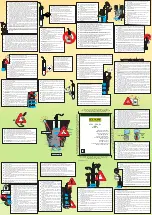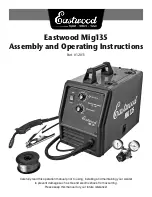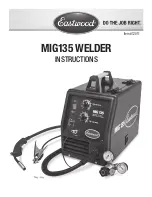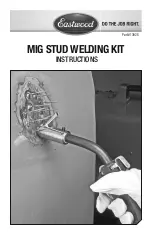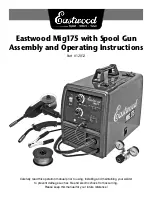
13
2. The gas hose, regulator and gas cylinder connections
Connect the gas hose to the gas solenoid valve on the back panel of the welder. Connect the other end to the
regulator connected to the shielding gas cylinder. See the following illustration.
3
2
1
7
Cylinder valve: Controls GAS CYLINDER flow.
1.
Cylinder pressure gauge
2.
Gas flow gauge, set at 20 CFM
3.
Regulator
4.
Adjustment knob: Controls gas flow to the welder.
5.
Gas hose
6.
Gas cylinder
NOTE:
Slowly open the cylinder valve by turning it counterclockwise until the cylinder pressure gauge registers the
cylinder pressure. Turn the adjustment knob clockwise slowly to increase gas flow to 20 CFM. To reduce the gas
flow turn the adjustment counterclockwise. The gas solenoid valve is on the back panel of the welder. Gas flow
can be heard at the end of the gun when the trigger is activated. No gas flow will result in a harsh arc with
excessive spatter, a smooth weld bead will not be obtained.
3. Gas Selection
Different materials require different shielding gas when MIG welding, refer to the set up chart inside the wire feed
compartment also.
Mild steel
: Use 75% Argon and 25% for reduced spatter and reduced penetration for thinner materials.
Do NOT USE Argon gas concentrations higher than 75% on steel. The result will be extremely poor penetration,
porosity, and brittleness of weld.
Mild Steel
: Use CO2 for deeper penetration but increased spatter.
Stainless steel
: Use a mixed gas consisting of Helium, Argon and CO2.
Aluminum or bronze
: Use 100% Argon
Содержание HIT140
Страница 5: ...5 Assembly B FOR GASLESS WELDING ...
Страница 6: ...6 C FOR GAS WELDING D FOR MMA WELDING ...
Страница 21: ...21 ...
Страница 22: ...22 ...























